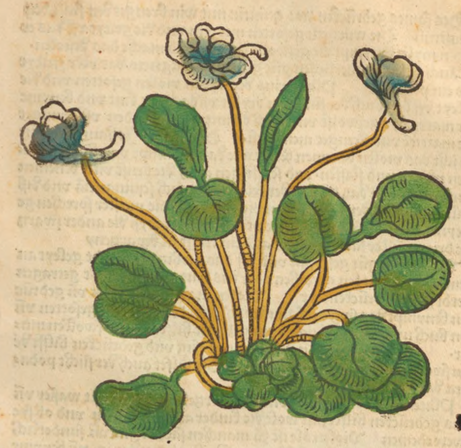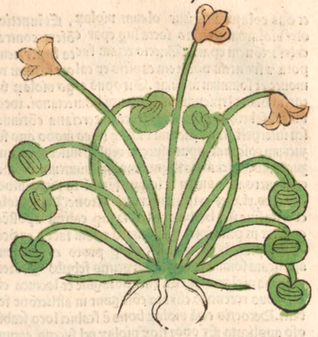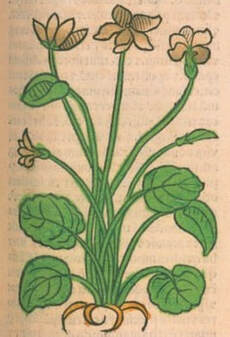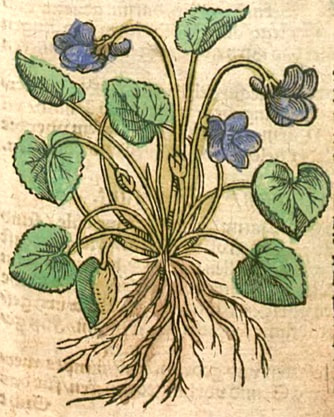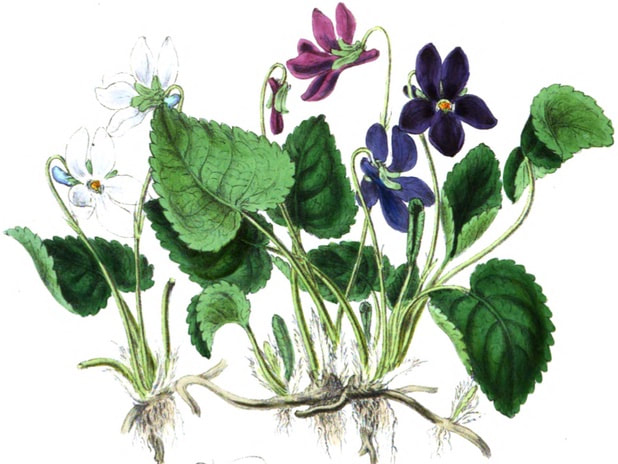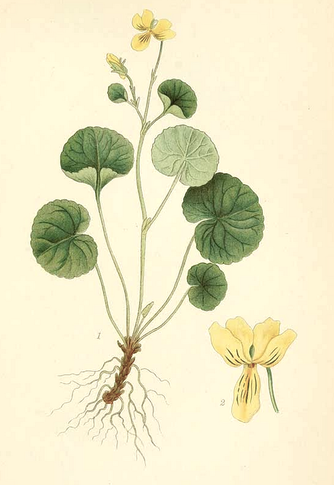Sentry Page Protection
Viola, Violet
Banafsha (Unani)
Zi Hua Di Ding 紫花地丁 (TCM)
Sngo Rta Rmig སྔོ་ རྟ་རྨིག་ (Tibet)
Zi Hua Di Ding 紫花地丁 (TCM)
Sngo Rta Rmig སྔོ་ རྟ་རྨིག་ (Tibet)
Gart der Gesundheit, Cuba, 1485
V. odorata
Kurtzes Handtbuchlein, Ryff, 1599
Kurtzes Handtbuchlein, Ryff, 1599
V. odorata
Plantæ Utiliores, Burnett & Burnett, 1842
Plantæ Utiliores, Burnett & Burnett, 1842
V. biflora (used in Tibetan Medicine)
Lindman, C.A.M., Bilder ur Nordens Flora (1922)
Lindman, C.A.M., Bilder ur Nordens Flora (1922)
Botanical name:
Viola spp.:
Parts used:
Leaf, Flower; rarely the Seed or Root
Temperature & Taste:
Cool, moist. Sweet, Bitter
"Cold and Moist in the First degree". (Avicenna)
Classifications:
2E LENITIVE. 2F. PURIFYING. 2J. RAREFYING. 2L. EMOLLIENT. 2U. SUPPURATIVE.
3B. FEBRIFUGE & ANTIPYRETIC. 3C. ALEXIPHARMIC. 3D. CORDIALS & CARDIACS. 3L. ANTI-TUSSIVE. 3M. ARTHRITIC
4a. CEPHALIC. 4c. CARDIAC. 4d. PECTORAL. 4e. STOMACHIC. 4f. SPLENETIC. 4g. HEPATIC. 4h. NEPHRITIC. 4i. UTERINE. 4j. NERVINE
Preparers and Purgers of Bile
TCM:
B. Clears Heat and Toxin B. Clears Deficient Heat
Viola spp.:
- V. odorata (West)
- V. philippica (syn. V. yedoensis, V. alisoviana), V. betonicifolia, V. patrini (TCM)
- V. biflora (Tibet)
Parts used:
Leaf, Flower; rarely the Seed or Root
Temperature & Taste:
Cool, moist. Sweet, Bitter
"Cold and Moist in the First degree". (Avicenna)
Classifications:
2E LENITIVE. 2F. PURIFYING. 2J. RAREFYING. 2L. EMOLLIENT. 2U. SUPPURATIVE.
3B. FEBRIFUGE & ANTIPYRETIC. 3C. ALEXIPHARMIC. 3D. CORDIALS & CARDIACS. 3L. ANTI-TUSSIVE. 3M. ARTHRITIC
4a. CEPHALIC. 4c. CARDIAC. 4d. PECTORAL. 4e. STOMACHIC. 4f. SPLENETIC. 4g. HEPATIC. 4h. NEPHRITIC. 4i. UTERINE. 4j. NERVINE
Preparers and Purgers of Bile
TCM:
B. Clears Heat and Toxin B. Clears Deficient Heat
Uses:
1. Clears Heat, Resists Poison:
-skin diseases with Heat and Poison such as Boils, Sores, Eczema
-acute sore or swollen Throat for which it may be used as a gargle.
-Scrofula, Syphilis and Rheumatism, and traditionally for venomous Bites
-seed has also been used for the stinging of Scorpions.
2. Clears Heat, Nourishes Yin, Resolves Swellings:
-conditions where the Yin has been damaged by Heat: Thirst of Fevers, Night Sweats, Consumption, Cachexia, wasting disorders.
-‘Ripen and dissolve Swellings’ including Scrofula, swollen nodes
-Tumors and Cancer including that of the Breast, Throat, Tongue, Lungs, Liver, Intestine, Lymph nodes, Soft Tissue etc.
-prevents metastases following surgical removal. (BHP specific)
3. Clears Heat, Calms the Mind, Stops Spasms, Eases Pain:
-irritability, restlessness and insomnia from heat as seen in Fevers, especially in Children
-over-excited children, or those with poor concentration.
-strong pain from Wind and Heat including severe Headaches
-early stages of Epilepsy and other nervous disorders
-'Powerful relaxant' (Galen)
4. Clears Heat and Phlegm, Stops Cough:
-severe coughs such as Whooping Cough, relieves pleurisy, hoarse throats, bronchitis and various Coughs.
-Shortness of breath associated with Heat or dryness.
-"Violet, especially its conserve made in sugar, is useful in hot cough and it relaxes the chest". (Avicenna)
-"Its syrup is useful in Pleurisy and Pneumonia". (Avicenna)
5. Clears Heat and Damp:
-Jaundice, Cholecystitis, Gall Stones;
-hot urinary conditions such as scanty or painful urine; it has been used for Nephritis.
-accessory herb for Rheumatism and Gout.
-"When taken dry, it expels Bile". (Avicenna)
6. Gentle Purgative and Emetic:
-Roots are emetic and purgative
-The roots were said to be superior to all other emetics; "a valuable substitute for Ipecacuanha’"
-The herb is used as a mild purgative, especially in heat diseases of children.
7. Externally:
-Poultices, Plasters, Oil and Ointments to all Hot Inflammations
-Poultices, Plasters and Ointments to all Swellings, Tumors and Cancers of the flesh and Breast.
-applied to Lymphatic Swellings.
-Infused Oil, Ointment or Poultice is good for Burning and Hectic Fevers (applied to the Heart and Pulses)
-Oil is applied to Scabies and Itching
-heat-type Pain in the Breast and Lungs.
-applied to the Head to abate the pain of Headaches
-"useful in Hot Conjunctivitis". (Avicenna)
-decoction is used for Prolapses of the Uterus and Rectum
Seed
Galen said the Seed promotes Labor and kills Worms.
Comment:
1. Violet leaf is one of the Five Emollient Herbs, along with Marshmallow, Beet, Mercury, Pellitory of the Wall, and Mallow
2. Violet flower is one of the Four Cordial Flowers, along with Rose, Bugloss and Borage.
3. The fresh plant is always preferred, and of that, the Flower is best.
4. The Flowers were most kept in the form of the Conserve; the Juice of the Whole Plant may be made into a Syrup to keep.
Dose:
INFUSION or BRIEF DECOCTION of the Whole Herb: 3–9 grams, up to 30 grams daily (dried), or 10–30 grams, up to 2 oz. fresh. In the Treatment of Cancer and other serious or chronic disease, or when used as a single herb, 1 oz. of the dried or 2 ½ oz. of the fresh leaves are steeped overnight in 1 pint of boiling water, and this is taken over the course of the following day;
TINCTURE (1:5 in 25% alcohol, the fresh plant tincture being best): 2–4, or 6 mls, up to 10, 15, or 20 mls for tumors and swellings, 2–3 times daily;
FLUID EXTRACT (1:1: in 25% alcohol): 2–4 mls, up to 6 mls, 2–3 times daily;
ROOT in POWDER: 1 ½–4 grams (normally 2 ½–3 grams is an Emetic for an adult);
STEMS in INFUSION: 1–2 oz. (as an emetic and purgative);
FLOWERS in POWDER: 250mg–1 gram (conserve of the flowers is best; see below).
Correctives:
1. Water Lily (Unani)
2. Marjoram (Unani)
Substitutes:
1. Mallow (Unani)
2. Borage (Unani)
1. Violet leaf is one of the Five Emollient Herbs, along with Marshmallow, Beet, Mercury, Pellitory of the Wall, and Mallow
2. Violet flower is one of the Four Cordial Flowers, along with Rose, Bugloss and Borage.
3. The fresh plant is always preferred, and of that, the Flower is best.
4. The Flowers were most kept in the form of the Conserve; the Juice of the Whole Plant may be made into a Syrup to keep.
Dose:
INFUSION or BRIEF DECOCTION of the Whole Herb: 3–9 grams, up to 30 grams daily (dried), or 10–30 grams, up to 2 oz. fresh. In the Treatment of Cancer and other serious or chronic disease, or when used as a single herb, 1 oz. of the dried or 2 ½ oz. of the fresh leaves are steeped overnight in 1 pint of boiling water, and this is taken over the course of the following day;
TINCTURE (1:5 in 25% alcohol, the fresh plant tincture being best): 2–4, or 6 mls, up to 10, 15, or 20 mls for tumors and swellings, 2–3 times daily;
FLUID EXTRACT (1:1: in 25% alcohol): 2–4 mls, up to 6 mls, 2–3 times daily;
ROOT in POWDER: 1 ½–4 grams (normally 2 ½–3 grams is an Emetic for an adult);
STEMS in INFUSION: 1–2 oz. (as an emetic and purgative);
FLOWERS in POWDER: 250mg–1 gram (conserve of the flowers is best; see below).
Correctives:
1. Water Lily (Unani)
2. Marjoram (Unani)
Substitutes:
1. Mallow (Unani)
2. Borage (Unani)
Main Combinations:
Dandelion & Violet
1. Cough:
i. Violet with Marshmallow
ii. Violet with Plantain leaf and Licorice
2. Whooping Cough, Violet with Sundew and Peony root (Kroeber)
3. Asthma:
i. Violet, Licorice, Turpeth. (see research below)
ii. Violet with Bitter Almond, Marshmallow, Licorice, Tragacanth, Fennel seed (as in Electuary for Asthma)
iii. Violet with Elecampane, Licorice, Sage, Maidenhair, Coltsfoot, Hyssop, Thyme, Aniseed (as in Syrup for Asthma)
4. Pleurisy, Violet with Melon seed, Mallow seed, Gum Arabic, Tragacanth (as in Syrup of Violet)
5. Allergic Rhinitis, Violet with Eyebright, Calendula, Wormwood
6. Heat of the Blood:
i. Violet with Meliot, White Dead Nettle, St. Johns wort (Zimmermann)
ii. Violet with Sorrel, Mallow, Plantain, Purslane, Endive (as in Decoction to Cool the Blood)
7. To purge Melancholy:
i. Violet with Polypody and Senna
ii. Violet with Senna, Polypody, Ginger, Raisin, Prune, Borage (as in Decoction of Senna)
iii. Violet with Dill seed, Aniseed, Licorice, Sorrel, Endive, Polypody, Mastic, Cinnamon (as in Powder of Polypody of Montagnana)
8. To clear Heat and Bile:
i. Violet with Borage, Chicory, Agrimony
ii. Violet with Prune, Tamarind, Barley, 4 Cold seeds (as in Decoction to Cool)
iii. Violet with Endive, Chicory, Agrimony, Borage, Tamarind, Licorice (as in Decoction to Expel Bile of Andernacus)
9. Skin diseases from Bile or Melancholy, Violet with Yellow Myrobalan, Dodder, Wormwood, Fumitory (as in Syrup of Fumitory Lesser of Mesue)
10. Nervous over-stimulation, insomnia and hysteria, Violet with Balm, Valerian, Yarrow (Schmidt)
11. Insomnia, Violet, Lettuce seed, Saffron
12 Migraine, Violet, Damask Rose, Coriander seed (this has been studied; see below).
13. Madness and Mental illness, Water Lily flower, Violet flower, Rose, Lettuce seed, Poppy seed, Red Coral, Red Sandalwood (as in Powder for Madness)
14. Palpitation, Arrhythmia, Fainting, Vertigo, Migraine, Violet with Rosemary, Rose, Licorice, Clove, Indian Spikenard, Nutmeg, Cinnamon, Ginger, Zedoary, Aloeswood, Cardamon (as in Powder of Rosemary)
15. Hot Inflammations, make a plaster of Violet and Barley flour. (Avicenna)
Major Formulas:
Decoction of Fruit
Decoction to Expel Bile of Andernacus
Decoction to Cool
Decoction to Cool the Blood
Syrup of Fumitory Lesser (Mesue)
Syrup of Violet Compound
Syrup of Violet (De morbus internis curandis)
Syrup of Jujube Compound (Mesue)
Syrup of Water Lily Flowers
Syrup for Asthma (Wirtzung)
Powder of Rosemary (Dianthos) (Nicholas)
Powder of Polypody of Montagnana
Powder for Madness
Pills of Violet (Unani)
Troches for Pleurisy (Mesue)
Troches for Pleurisy from Heat with Vehement Fever
Electuary for Asthma (1) (De Morbis internis curandis, 1551)
Electuary to Restore Humidity (Arnold de Villa Nova)
Electuary of Prunes (Diaprunis lenitiva) (Nicholas)
Cautions:
Generally Safe. ‘Mild Nature, in no way harmful’ (Culpeper)
1. Use cautiously in cold and weak digestive systems.
2. Large doses should be avoided in children.
Toxicity:
No obvious toxic effects were noted in animals receiving water extracts of up to doses of 1.6g/kg.
Main Preparations used:
Solutive Syrup of Violets, Syrup of the Juice, Compound Syrup, Julep of Violets, Conserve of the Flowers, Infused Vinegar of the Flowers, Infused Oil, Distilled Water of the herb and of the flower, Tincture, Extract of the Juice Dehydrated, Troches
1. Conserve of Violet flower:
i. Fresh Violet flowers (1 part), White Sugar (2 parts). Beat.
2. Violet Water:
i. Violet flowers (1 part), Water (4 parts). Infuse 6 hours, distil 2 parts. (Pharmacopoeia Sardoa, 1773)
3. Syrup of Violet:
i. Violet flowers (2 parts), Boiling Water (8 parts), White Sugar (15 parts). Macerate flowers for 24 hours, strain and add the Sugar.
4. Oil of Violets:
i. Violet petals (1 ½ parts), Olive oil (3 parts). Digest in a gentle heat for 2 days; express, and repeat with fresh flowers. (Pharmacopoeia Sardoa, 1773)
Generally Safe. ‘Mild Nature, in no way harmful’ (Culpeper)
1. Use cautiously in cold and weak digestive systems.
2. Large doses should be avoided in children.
Toxicity:
No obvious toxic effects were noted in animals receiving water extracts of up to doses of 1.6g/kg.
Main Preparations used:
Solutive Syrup of Violets, Syrup of the Juice, Compound Syrup, Julep of Violets, Conserve of the Flowers, Infused Vinegar of the Flowers, Infused Oil, Distilled Water of the herb and of the flower, Tincture, Extract of the Juice Dehydrated, Troches
1. Conserve of Violet flower:
i. Fresh Violet flowers (1 part), White Sugar (2 parts). Beat.
2. Violet Water:
i. Violet flowers (1 part), Water (4 parts). Infuse 6 hours, distil 2 parts. (Pharmacopoeia Sardoa, 1773)
3. Syrup of Violet:
i. Violet flowers (2 parts), Boiling Water (8 parts), White Sugar (15 parts). Macerate flowers for 24 hours, strain and add the Sugar.
4. Oil of Violets:
i. Violet petals (1 ½ parts), Olive oil (3 parts). Digest in a gentle heat for 2 days; express, and repeat with fresh flowers. (Pharmacopoeia Sardoa, 1773)
Click the Tabs above for more information on this Medicine
Last Updated 02/24

